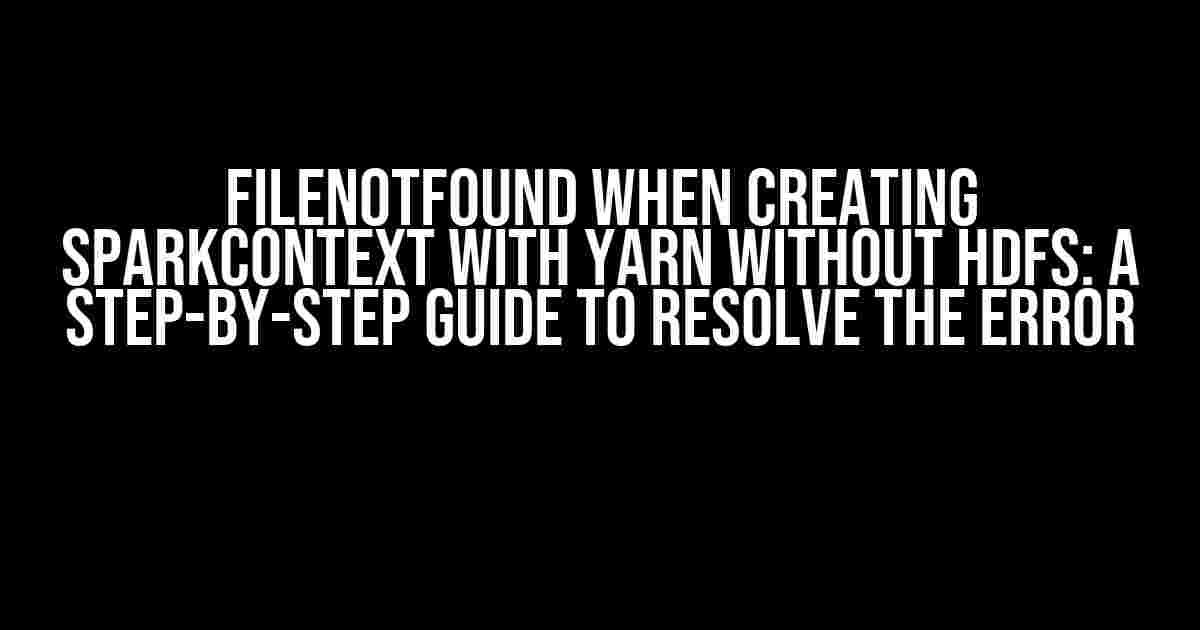Are you tired of encountering the dreaded FileNotFound error when trying to create a SparkContext with YARN without HDFS? Look no further! In this comprehensive guide, we’ll take you through the troubleshooting process, providing clear and direct instructions to resolve this frustrating issue.
Understanding the Error
The FileNotFound error typically occurs when Spark is unable to find the Jar files or configuration files required to launch the application. When using YARN without HDFS, Spark relies on the local file system for storing and retrieving files. However, if the necessary files are not present or accessible, Spark throws the FileNotFound exception.
Cause 1: Missing Jar Files
One of the most common causes of the FileNotFound error is the absence of the Spark Jar files. When submitting a Spark application to YARN, Spark needs to access the Jar files containing the application code and dependencies. If these files are not present in the expected location, the error occurs.
Solution:
To resolve this issue, ensure that the Spark Jar files are present in the correct location. You can do this by:
- Verifying that the Spark installation is correct and complete.
- Checking that the Jar files are present in the
$SPARK_HOME/jarsdirectory. - Setting the
spark.jarsproperty in your SparkConf to point to the correct location.
Example code snippet:
val conf = new SparkConf()
.setMaster("yarn")
.set("spark.jars", "/path/to/spark/jars")
.setAppName("My Spark App")
val sc = new SparkContext(conf)Cause 2: Inaccessible Configuration Files
Another common cause of the FileNotFound error is the inaccessibility of configuration files. Spark relies on configuration files, such as spark-defaults.conf and yarn-site.xml, to determine the application’s behavior and YARN’s configuration.
Solution:
To resolve this issue, ensure that:
- The configuration files are present in the correct location.
- The files are readable by the Spark application.
- The files are correctly configured for YARN mode.
Example configuration file snippet:
spark.master yarn
spark.yarn.jar /path/to/spark/assembly/jar
spark.yarn.executor.memory 1g
spark.yarn.executor.cores 2Troubleshooting Steps
Follow these steps to troubleshoot the FileNotFound error:
- Verify the Spark installation and Jar files.
- Check the configuration files for correctness and accessibility.
- Verify the SparkConf settings, especially the
spark.jarsproperty. - Check the YARN logs for any error messages or warnings.
- Try submitting the Spark application with the
--verboseflag to gather more detailed logs.
Common Pitfalls and Solutions
| Pitfall | Solution |
|---|---|
Missing spark-assembly.jar |
Build and include the spark-assembly.jar in the $SPARK_HOME/assembly directory. |
Incorrect spark.jars property |
Verify that the spark.jars property points to the correct location of the Jar files. |
| Inaccessible configuration files | Ensure that the configuration files are present in the correct location and are readable by the Spark application. |
| YARN configuration issues | Verify that the YARN configuration files, such as yarn-site.xml, are correctly configured for YARN mode. |
Conclusion
By following this comprehensive guide, you should be able to resolve the FileNotFound error when creating a SparkContext with YARN without HDFS. Remember to verify the Spark installation, Jar files, and configuration files, as well as troubleshoot the issue using the steps outlined above. With persistence and patience, you’ll be able to overcome this frustrating error and successfully run your Spark application on YARN.
So, the next time you encounter the FileNotFound error, don’t panic! Instead, follow this guide, and you’ll be well on your way to resolving the issue and getting your Spark application up and running.
Happy Spark-ing!
Here is the requested HTML code with 5 questions and answers about “FileNotFound when creating SparkContext with YARN without HDFS”:
Frequently Asked Question
Get answers to the most frequently asked questions about FileNotFound when creating SparkContext with YARN without HDFS.
Why do I get a FileNotFoundException when creating a SparkContext with YARN without HDFS?
This error typically occurs because Spark is trying to access a file that doesn’t exist. Make sure you have the correct file path and that the file is available to all nodes in your YARN cluster. Also, ensure that the file is not dependent on HDFS, as you mentioned you’re not using it.
What are some common reasons for FileNotFoundException in Spark with YARN?
Some common reasons include incorrect file paths, file permissions issues, files not being available to all nodes in the YARN cluster, or Spark dependencies not being correctly configured. Additionally, if you’re using a Spark application jar, ensure it’s correctly packaged and available to all nodes.
How do I troubleshoot a FileNotFoundException in Spark with YARN?
To troubleshoot, first check the Spark application logs to identify the file path that’s causing the error. Then, verify that the file exists and is accessible to all nodes in your YARN cluster. If you’re using a Spark application jar, ensure it’s correctly packaged and available to all nodes. You can also try running your Spark application in local mode to isolate the issue.
Can I use YARN without HDFS for my Spark application?
Yes, you can use YARN without HDFS. YARN (Yet Another Resource Negotiator) is a resource management layer that allows you to run Spark applications on a cluster without relying on HDFS (Hadoop Distributed File System). Instead, you can use other storage systems like S3, NFS, or local file systems.
What are some alternatives to HDFS for storing files in a YARN cluster?
Some popular alternatives to HDFS for storing files in a YARN cluster include Amazon S3, Google Cloud Storage, Azure Blob Storage, NFS (Network File System), and local file systems like ext4 or XFS. Each has its own advantages and disadvantages, so choose the one that best fits your use case.
